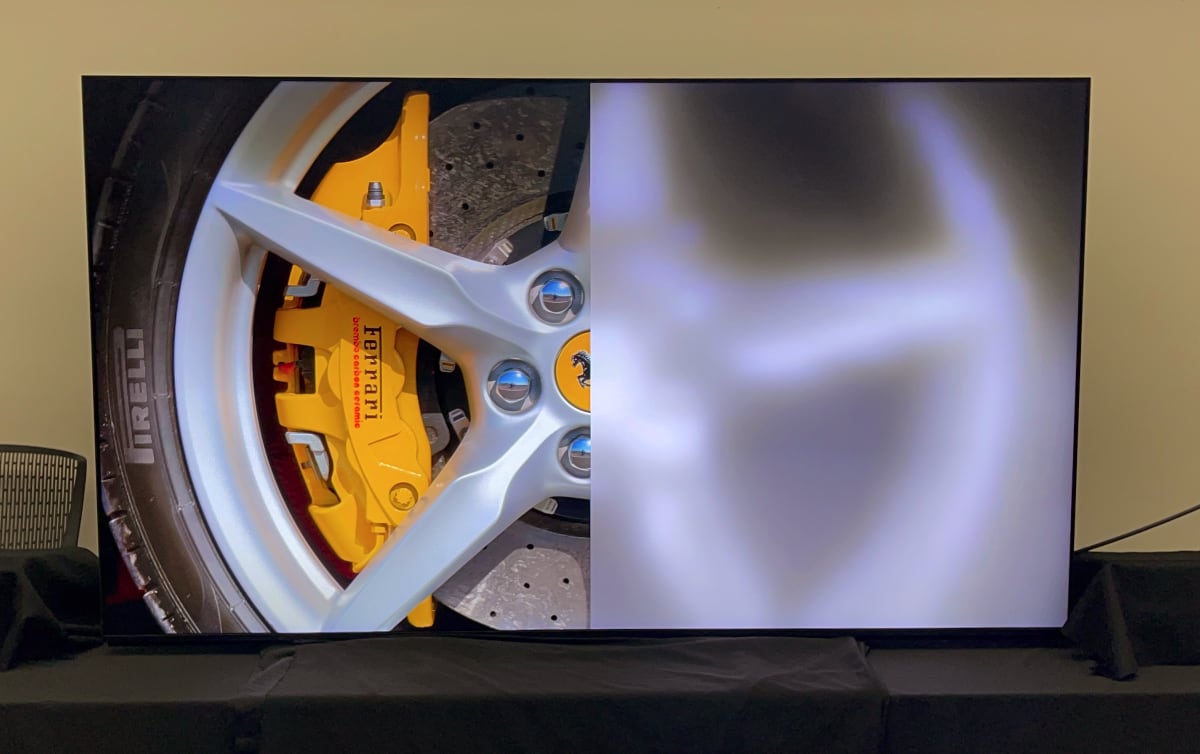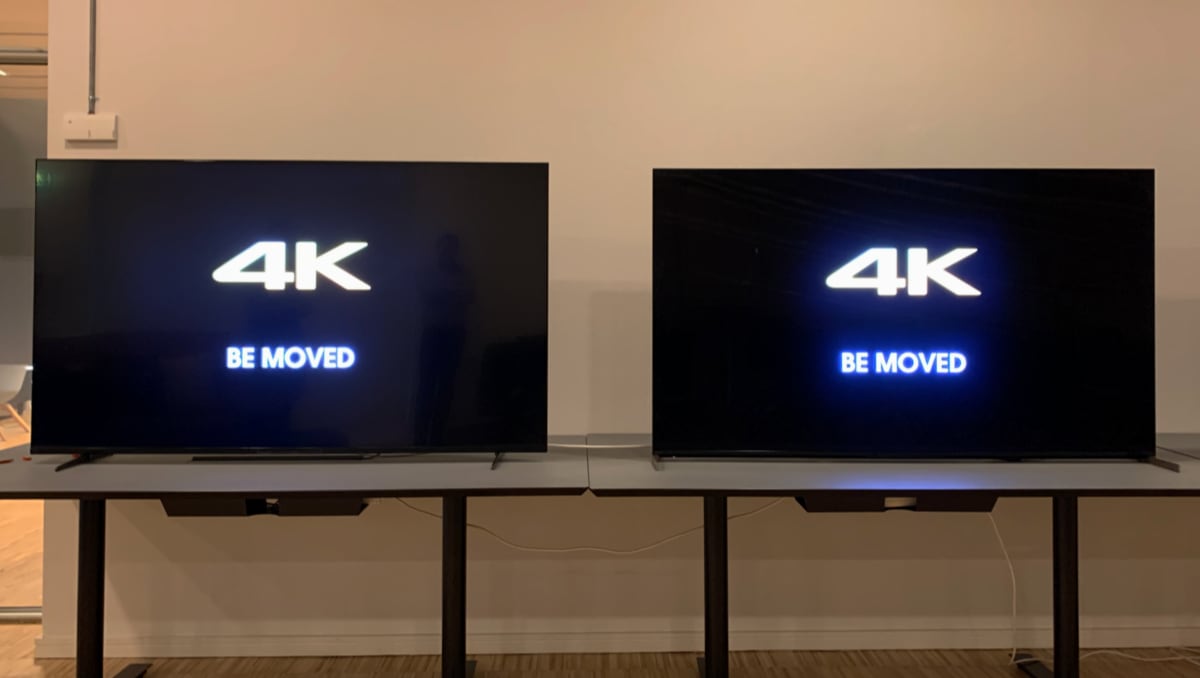
Sony is not announcing new TVs at CES 2024 but the company gave FlatpanelsHD a unique preview of its next-generation miniLED technology planned for an upcoming flagship LCD TV.Update: Article has been updated with two videos, shot by FlatpanelsHD, of Sony's new miniLED LCD technology.
With TCL moving to 5000 miniLED dimming zones in its latest LCD TVs, Sony is gearing up to counter with upgraded miniLED LCD technology aimed at improving picture quality and reducing power consumption. During an event last year in Tokyo, Japan, attended by FlatpanelsHD, Sony's display engineers showcased and discussed the technology for the first time. Unfortunately, we are not yet able to share information on the actual product or sizes. However, we can share some video of the new technology, information and thoughts ahead of the official announcement. While Sony did not specifically say that it is coming in 2024, there were enough indications that we fully expect it to happen this year.Sony's next-gen miniLED LCD tech
Sony's display engineers argued that effective local dimming, miniLED or otherwise, in an LCD TV is primarily determined by 3 components:Sony believes it masters these disciplines better than any other, even if its LCD TVs do not always have the highest number of dimming zones among TV makers. In 2024, Sony will transition to a new 22-bit miniLED driver (10-bit current + 12-bit PWM, while the LCD panel remains 10-bit). The company claims that this driver is the world's smallest, enabling the incorporation of more dimming zones. The 2024 miniLED LCD TV will feature more dimming zones and while Sony is not disclosing the exact number of zones, it did say that each TV size will have more zones than the equivalent Z9D/ZD9, which significantly raised the standard for local dimming back in 2016. Of course, there have been advancements in the field since then.
- The TV processor, responsible for dividing the input signal into LCD and LED backlight data (sometimes referred to as the "dimming algorithm").
- The driver, tasked with converting the LED backlight data into analog signals.
- The (mini)LED backlight, which transforms the electrical signal into visible light (then regulated for light/color levels by the LCD panel).
Sony's 2024 miniLED LCD technology revealed. Read on. Photo: FlatpanelsHD
Sony compared its 2024 prototype to last year's X95L miniLED LCD model, saying that the 2024 model is 1.5x brighter as of the Tokyo demo but the final result will depend on tweaks. Despite this, overall power consumption is reduced by 10-15%, and in Eco mode there is a 30% reduction (2023's X95L is rated as G on EU's energy label, but Sony aims for a better energy class this year). This efficiency improvements are attributed to the new LED driver, which regulates the miniLED zones for every picture frame. As for the official name of the 2024 flagship TV, it is anyone's guess at this point (perhaps Z95M? Or X95M?).Two demonstrations
In Tokyo, Sony had two demonstrations of its 2024 miniLED LCD technology. The first demo had one half of the LCD panel removed, revealing the effect of the miniLED zone dimming backlight on the exposed section – something Sony had never publicly demonstrated before. We were not allowed to film this part of the demo. In this first demo, Sony's 2024 TV was compared to one of Samsung's flagship miniLED LCD models ("Neo QLED") – also with one half of the LCD panel removed – and a significant difference was observed in bright scenes. While the majority of Samsung's miniLED dimming zones were running at full steam in this very bright scene, Sony's miniLED zones carefully and gradually intensified and dimmed in sync with the picture content, which should translate to better light control in the picture you see at home.
Sony X95K de 2022 (à direita). O brilho em torno de objetos brilhantes é uma das desvantagens do escurecimento da área do miniLED. A floração pode ser reduzida aumentando o número de zonas. Imagem: Painéis planos HD
Na segunda demonstração, a TV Sony 2024 é comparada com a Sony X95L (2023 miniLED LCD) e Sony A80L (2023 WOLED). Durante parte da demonstração, os dois primeiros mostraram apenas os efeitos de escurecimento da área miniLED (sem exibir imagem do painel LCD), enquanto a TV OLED exibia o conteúdo real para referência. Em outras palavras, vimos várias zonas miniLED com isolamento esmaecido e aprimorado. Aqui, a maior resolução do sistema miniLED no modelo 2024 e pela primeira vez num sistema de escurecimento de zona bruta permitiu-nos distinguir alguns detalhes de luminância da imagem real (exibida numa TV OLED para referência) devido ao aumento do número de zonas. Por exemplo, o logotipo da Sony centralizado em branco brilhante em um fundo preto simplesmente apareceu como um ponto branco no 2023 X95L, mas era bastante legível quando visto com a área miniLED inicial do modelo 2024 esmaecida (a TV está centralizada no vídeo). Imagine uma TV LCD com, por exemplo, 3.000 zonas de dimerização. Neste exemplo, a resolução da retroiluminação miniLED será em torno de 40x74 (= 2.960 áreas), o que é muito inferior à resolução do painel LCD 4K (3840x2160 = 8294400) à sua frente, mas alta o suficiente para reproduzir pelo menos alguns detalhes de luminância em sua forma bruta e ajudam a reduzir o florescimento - ou halos - na imagem real que você vê. Assista aos dois vídeos de demonstração que FlatpanelsHD filmou durante a demonstração em Tóquio:Esquerda: O Sony X95L (2023) mostrando o escurecimento da área miniLED. Centro: A tecnologia LCD miniLED 2024 (protótipo) mostra seu escurecimento de área miniLED. À direita: Sony A80L OLED exibe conteúdo de imagem para referência. Vídeo: painéis planos HD
2024 A tecnologia MiniLED LCD da Sony (protótipo) mostra escurecimento de sua área miniLED em metade da tela. Vídeo: painéis planos HD
Em outra parte da demonstração, analisamos o conteúdo de imagem real, especialmente cenas brilhantes ou cenas HDR de alto contraste, que são exibidas nas três TVs. O protótipo 2024 apresentou uma imagem visivelmente melhor em relação ao 2023 X95L e superou o desempenho do A80L OLED em cenas muito brilhantes. Leia também: Exposto: como funciona a retroiluminação miniLED de 5.000 zonas (TCL X955)Também vimos o impacto no consumo de energia, demonstrado pelo medidor de energia instalado em cada uma das três TVs Sony. Isso foi feito em parte para revelar que o menor consumo de energia do modelo 2024 não afetou a eficácia da retroiluminação miniLED. Aliás, se a Sony fizer esse corte, ela anunciará um recurso relacionado muito legal em 2024.Um grande salto para as pequenas telas LCD da Sony
As demonstrações focaram nos avanços no escurecimento da área miniLED, dificultando a avaliação da qualidade da imagem final com conteúdo misto. No entanto, nosso feedback durante a demonstração relativamente curta foi promissor, indicando um grande avanço para os LCDs MiniLED da Sony. No entanto, não estamos convencidos de que esta tecnologia desequilibre a balança de poder ou se aproxime do desempenho das melhores TVs OLED do mercado, como a Sony A95L QD-OLED. Leia também: Análise: Sony A95L (QD-OLED)Mais tarde, FlatpanelsHD terá a oportunidade de ver o produto final e fornecer todos os detalhes sobre a nova TV que esperamos ser o modelo principal do LCD miniLED 2024 da Sony, enquanto o A95L QD-OLED do ano passado será estendido até 2024.

“Empreendedor autônomo. Comunicador. Jogador. Explorador. Praticante de cultura pop.”






More Stories
Harry Potter: o nível de pomo dos campeões de quadribol foi significativamente reduzido no PS5 e PS4
Vazamentos sobre planos de anúncio do PS5 Pro e design de dispositivos
Lançamento físico da Castlevania Dominus Collection confirmado, pré-encomendas abertas no próximo mês